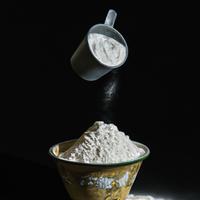
1 serving (30 grams) contains 110 calories, 3.5 grams of protein, 0.3 grams of fat, and 23.0 grams of carbohydrates.

Log this food in SnapCalorie

Nutrition Information
Calories |
440 | ||
|---|---|---|---|
% Daily Value* |
|||
| Total Fat | 1.2 g | 1% | |
| Saturated Fat | 0 g | 0% | |
| Polyunsaturated Fat | 0 g | ||
| Cholesterol | 0 mg | 0% | |
| Sodium | 2.4 mg | 0% | |
| Total Carbohydrates | 92 g | 33% | |
| Dietary Fiber | 3.6 g | 12% | |
| Sugars | 0.4 g | ||
| protein | 14 g | 28% | |
| Vitamin D | 0 mcg | 0% | |
| Calcium | 24 mg | 1% | |
| Iron | 2.8 mg | 15% | |
| Potassium | 120 mg | 2% | |
* Percent Daily Values are based on a 2,000 calorie diet. Your daily values may be higher or lower depending on your calorie needs.
Food Attributes
Source of Calories
About Quarter cup of flour
A quarter cup of flour is a common measurement used in cooking and baking, typically referring to all-purpose flour, which is made from finely ground wheat. Flour originated as a staple ingredient in ancient cuisines and is now a cornerstone in recipes around the world, from breads to cakes to sauces. A quarter cup contains approximately 100 calories, 21 grams of carbohydrates, and 3 grams of protein. It provides energy but is low in fiber and micronutrients unless it’s fortified or made from whole grains. While regular flour lacks significant health benefits, choosing whole-wheat or alternative flours like almond or oat can provide more fiber, vitamins, and minerals. Regular all-purpose flour is low in fat and sugar, but consuming it in excess or in refined baked goods can contribute to weight gain and fluctuating blood sugar levels. It’s best enjoyed in moderation as part of a balanced diet.



